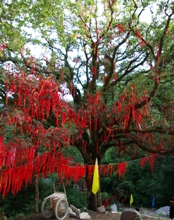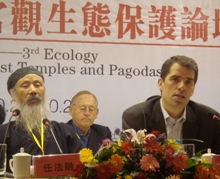| |
|
 |
Daoists in China issue an Eight Year Plan for Generational Change on the Environment
November 6 2008:
 |
 |
 |
The Daoists are planning to plant, and protect, many trees in their Eight Year Plan |
Link here to download the latest guidelines document to the full Seven Year Plan. (Note this is a file of 2MB).
The first “Seven Year Plan” in the ARC-UN Programme to work with faiths for Generational Change was created last week by some of Daoism’s most senior leaders, who met at the first ever pan-China Daoist Ecology conference in Jurong, near to the sacred mountain of Mao Shan.
However, since eight is an auspicious number in Daoism and in China, they decided to dub it an Eight Year Plan instead, stretching from the beginning of 2010 when the plan will be announced, to the end of 2017 when it is hoped that plans and procedures will have been put in place which will protect China’s environment (and inspire others to do the same) for years and generations to come.
The Eight Year Plan follows the principle that the Dao Follows Nature. It is a natural extension of the MaoShan Declaration, which was the main written outcome of the conference, and which calls for all Daoists to “change our feelings and behaviour to realize the sacred goal that we share: to build ecological temples and forge our heaven on earth.”
The conference was co-hosted and co-organised by ARC. It was titled the Third Daoist Ecology Conference, because the process started two years ago in 2006 with a conference at the first Daoist Ecology Temple on the sacred mountain of Taibaishan for some 14 monks, followed by a second conference for 18 abbots last June. This latest conference, for 69 monks and nuns, was by far the biggest, and the first to attract representatives from Daoist monasteries from all over China.
Practical ProposalsSome of the many practical proposals in the draft document, which is being presented for formal backing to the China Daoist Association in Beijing this month, include:
• adding ecological dimensions to all Daoist businesses and industries (including sales of incense sticks, which will now be of the low-pollution variety),
 |
 |
 |
The Daoist God of Environmental Protection, the Sage Lao Zi. |
• calling for more environmentally friendly forms of pilgrimage (something that could have a huge impact as millions of Chinese people visit sacred mountains and temples every year)
• instituting plans to bring young people on youth camps into nature,
• building and agreeing standards for what constitutes and ecological temple, and
• incorporating environment more centrally into traditional cosmic dances.
Fuller details of the proposals and ideas can be found in the Eight Year Plan Draft Document itself.
Eco-Twinning
 |
 |
 |
The Third Daoist Ecology Forum attracted representatives from Daoist monasteries from all over China.
|
The event also included one of the first Eco-Twinning agreements within ARC’s programme to link groups, dioceses, temples etc of similar ecological interests. In this agreement, made at the end of the conference the Maoshan Daoist Temple in Jiangsu Province linked with the Zhongnan Mountain Gu Lou Temples in Shanxi Province, committing to exchange personnel and information to make both temples stronger ecological. This is hoped to be a model for many future
The Ecology ForumThe Daoist Ecology Forum included 69 senior monks and nuns from all around the country, helped and observed by at least 120 government officials, including senior members of the religious bureau, and with high level UN representation.
It was hosted by the Mao Shan Temple, and assisted by the Alliance of Religions and Conservation, as well as the Dutch-based environmental NGO, EMF.
The Mao Shan DeclarationThe Mao Shan Declaration advocates a better use of land, forest and water resources, and calls for all the faithful to make the landscape in and around Daoist temples greener and more beautiful. It pledges to put in place proper facilities that will help protect water resources and deal with pollution, build systematic plans and regulations that will help to promote environment protection programs, and education, and use energy saving technology and materials in order to build a benign ecological link between living areas and the natural environment.
It also promises that in the next ten years, our ecological temples project will focus on the following seven areas
1. Putting great effort into ecological education and training. Expanding materials and education about the natural environment, that will be open to pilgrims and ordinary people who visit our temples and mountains.
2. Advocating simpler lifestyles that will reduce energy and energy costs.
3. Participating in Social environmental activities with the community.
-
4. To enhance cooperation with the media to spread the word about ecology
 |
 |
 |
Old Master Ren of Louguantain Temple, with Olav Kjorven, Deputy assistant director of UNDP |
5. To build ecological temples
6. Maximizing the ecological benefit Daoists can achieve from our assets
7. Building and maintaining a Daoist Ecological Protection Network.
Key Comments by Participants “Today, the Daoists are working with Alliance of Religions and Conservation to develop an [Eight Year] Plan for Ecological Protection aimed to bring generational changes. I believe this plan will enable China's Daoist community to establish a new model of Daoist environmental protection...
In fact, the development of any religion needs to involve advancing with the times and adjust and developing those activities which embody the spirit of the times. In today's increasingly serious ecological crisis, the sense of need for an environmental protection campaign is spreading like wildfire throughout the country. The active participation of religious groups in this will not only expand the potential of the religions to develop, it will also mean that both religion and society will gain.” Guo Wei, Director General of Foreign Affairs Department of State Administration for Religious Affairs, P.R.C.
“From ancient times, Chinese Daoism has always put a great emphasis on Dao following nature. It pays a great attention to the harmony and balance of heaven, earth and humanity, and the balance between Yin and Yang. Humanity should obey nature’s rules, maintain the balance of our ecological system and protect the species that live beside us. This unique wisdom will be a powerful and effective weapon for us to battle the environment problems we are facing. Today, Daoism stands in the frontline of our times: it wishes to guide people through the obstacles of environmental problems through their own Daoist beliefs, and it wishes to rekindle the fire of our old wisdom to bring us new inspiration and hope,” The Daoist Eight Year Plan.
"The Daoists are walking the talk. Over the past year or so they have installed solar panels on half of their thousands of temples around China and the job will be completed soon for all their sacred places. They are providing comprehensive guidance on all aspects of environmental and climate stewardship: water and land management, protection of biological diversity, energy efficiency of buildings, educational curricula, moral teachings, outreach through media and advocacy to business, etc. They will use a new Eight-Year Plan for Generational Change to make a holistic and systematic contribution to climate responsibility and environmental stewardship in China. The perspective goes beyond eight years. The ambition is to change the course for generations to come. Because the Daoists plan to be around for quite a while longer, continuing their sacred cosmic dances that transcend time and space," Olav Kjorven, Assistant Secretary General, of UNDP. *** Link here for the full article.
"The draft recommendations for the Daoist Eight Year Plan are inspirational. And the plan is achievable for five reasons.
1. For every idea, and item in the plan, there is already a temple doing something. For example, education centres already exist in so many temples, and you can learn from each other.
2. The Network of Daoist Temples links temples which are committed to the environment, and which already lead by example.
3. Some new areas such as the youth camps build upon ideas and experiences. Fore example, Master Liu from Purple Cloud Temple spoke of his joy at hearing more birds in the morning, because nature in his area was recovering after years of suffering. Imagine how taking young people from crowded cities to the peace and beauty of nature will awaken respect and love for nature.
4. This can largely be done by using the resources you already have. In the spirit of the Dao this MUST be a programme that you can sustain and where the energy comes from you, although sometimes with a little help from outside.
5. This Eight Year Plan is not something that outsiders have created. This plan breathes with the energy of the Dao. It is founded upon the wisdom of Lao Zi. It is filled with the vision of Daoism. It is how Daoism will help to shape the wonderful harmony and balance which China and the world require. You, as Daoists, are the strength of this plan.
Martin Palmer Secretary General of ARC
It has never been more urgent to create a good ecological environment and maintain a dynamic balance and virtuous cycle of natural world. Daoism has an abundance of ethical principles ...promoting "harmony between humanity and nature", and with good ideas such as “love for nature, respect for nature”. Without doubt, these ideas and principles have a very high possibility of guiding us to deal with ecological crises, and to protect our surroundings. Over the past three days Daoist Masters and academic experts have explored and discussed the experiences and ways of how China Daoist temples have dealt with environmental problems. These discussion have produced an Ecology Protection Eight Year plan (2010-2017 ) for China Daoist temples to act. It can be said that the theme of the conference is sharp, the vision is insightful, and the outcome is excellent. It will surely bring a positive and far-reaching impact to China - even the world - on environmental protection.
Yin Weidong, Mayor of Jurong Municipal People's Government.
PERSPECTIVE FROM THE UNDP: why this matters“First, the Chinese Daoists have been around for thousands of years. They have seen countless dynasties come, and go. But the Dao (or “the Way”) has outlasted them all, proving its resilience and strength. Daoist values and beliefs continue to hold enormous sway in Chinese society," writes UNDP Assistant Secretary General Olav Kjorven in a blog written for UN and wider readership.
Secondly, these values and beliefs are now welcomed back into the broader discourse of society, on matters such as economic, social and environmental policy. Daoism is no longer confined to the personal and family levels, and to festivals and rituals. Daoist temples and their masters are increasingly addressing politicians and business leaders at all levels about environmental and other challenges. This week’s gathering was actively attended by government officials. In their statements, they asked the Daoists for help in building a more environmentally harmonious and sustainable China. They had come to realize that in order to solve current challenges and secure a sustainable future, they indeed needed to mobilize all of society. Today, this includes religion, and not just the Daoists.
Third, and what makes this doubly interesting, Daoism probably has more on offer to the environmental cause in today’s China than any other major, organized religion. This is a strong statement, but anyone who has read key Daoist masters such as Lao Zi and Chuang Tsu knows to what extent this faith tradition emphasizes environmental stewardship as a sacred duty, something we simply must do in order to preserve our future and the balance of the entire world. Take climate change. The whole problem and challenge can be beautifully captured and explained through the concepts of Yin and Yang: The carbon balance between earth and sky is off kilter. This causes instability and disasters. It is truly significant that the current masters of Daoism in China have started to communicate precisely through this ancient yet new vocabulary.
Fourth, the Daoists are walking the talk. Over the last year or so they have installed solar panels on half of their thousands of temples around China and the job will be completed soon for all their sacred places. They are providing comprehensive guidance on all aspects of environmental and climate stewardship: water and land management, protection of biological diversity, energy efficiency of buildings, educational curricula, moral teachings, outreach through media and advocacy to business, etc. They will use a new Eight-Year Plan for Generational Change to make a holistic and systematic contribution to climate responsibility and environmental stewardship in China. The perspective goes beyond eight years. The ambition is to change the course for generations to come. Because the Daoists plan to be around for quite a while longer, continuing their sacred cosmic dances that transcend time and space.
For the full article, by UNDP’s Assistant Secretary General Olav Kjorven, please link here.
Links*** Link here to download the latest guidelines document to the full Seven Year Plan. (Note this is a file of 2MB)
*** Link here for the Chinese Daoists' draft Ecology Protection Eight Year Plan.
*** Link here to learn more about the ARC/UN/Faiths Seven Year Plan Programme.
*** Link here for the latest news from around the world of faiths taking up Seven - or Eight - Year Plans.
*** Link here for more details about the Third Daoist Ecology Conference at Jurong.
here for the Mao Shan Declaration - in Chinese and English.
*** Link here for details of Martin Palmer's talk at the Daoist Ecology Forum in Jurong.
*** Link here for ARC's response to the Daoist Ecology Forum in Jurong.
*** Link here for details of UN's representative, Olav Kjorven's speech at the Third Daoist Ecology Forum in Jurong.
*** And link
here to read an article on Daoism and climate change written by Olav Kjorven.
*** Link here for more Daoist eco-news.
*** Link here to download the Daoist Eight Year Plan in pdf (209KB).
*** Link
here to download the Mao Shan Declaration in pdf (116KB).
|
 |
 |
|
|
|
|
|

